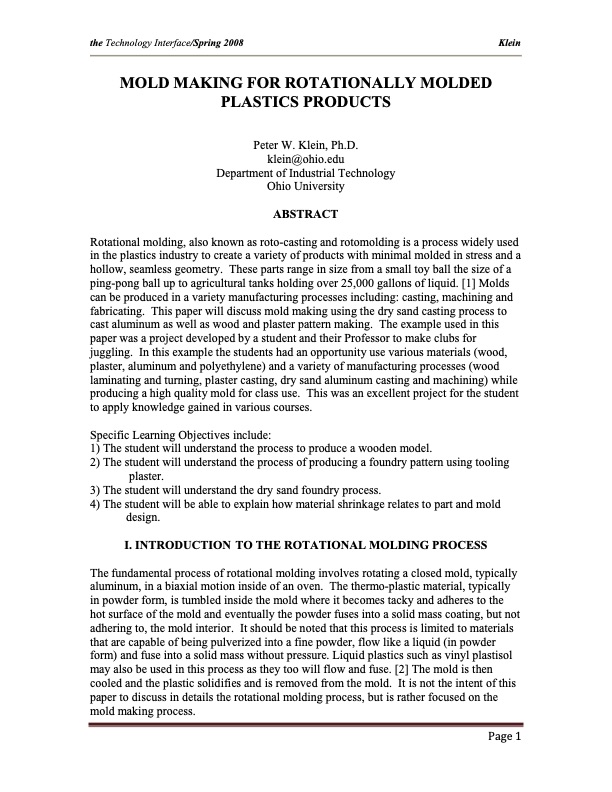
PDF Publication Title:
Text from PDF Page: 001
the Technology Interface/Spring 2008 MOLD MAKING FOR ROTATIONALLY MOLDED PLASTICS PRODUCTS Peter W. Klein, Ph.D. klein@ohio.edu Department of Industrial Technology Ohio University ABSTRACT Klein Rotational molding, also known as roto-casting and rotomolding is a process widely used in the plastics industry to create a variety of products with minimal molded in stress and a hollow, seamless geometry. These parts range in size from a small toy ball the size of a ping-pong ball up to agricultural tanks holding over 25,000 gallons of liquid. [1] Molds can be produced in a variety manufacturing processes including: casting, machining and fabricating. This paper will discuss mold making using the dry sand casting process to cast aluminum as well as wood and plaster pattern making. The example used in this paper was a project developed by a student and their Professor to make clubs for juggling. In this example the students had an opportunity use various materials (wood, plaster, aluminum and polyethylene) and a variety of manufacturing processes (wood laminating and turning, plaster casting, dry sand aluminum casting and machining) while producing a high quality mold for class use. This was an excellent project for the student to apply knowledge gained in various courses. Specific Learning Objectives include: 1) The student will understand the process to produce a wooden model. 2) The student will understand the process of producing a foundry pattern using tooling plaster. 3) The student will understand the dry sand foundry process. 4) The student will be able to explain how material shrinkage relates to part and mold design. I. INTRODUCTION TO THE ROTATIONAL MOLDING PROCESS The fundamental process of rotational molding involves rotating a closed mold, typically aluminum, in a biaxial motion inside of an oven. The thermo-plastic material, typically in powder form, is tumbled inside the mold where it becomes tacky and adheres to the hot surface of the mold and eventually the powder fuses into a solid mass coating, but not adhering to, the mold interior. It should be noted that this process is limited to materials that are capable of being pulverized into a fine powder, flow like a liquid (in powder form) and fuse into a solid mass without pressure. Liquid plastics such as vinyl plastisol may also be used in this process as they too will flow and fuse. [2] The mold is then cooled and the plastic solidifies and is removed from the mold. It is not the intent of this paper to discuss in details the rotational molding process, but is rather focused on the mold making process. Page 1PDF Image | 12 mil Reinforced Polyethylene

PDF Search Title:
12 mil Reinforced PolyethyleneOriginal File Name Searched:
Klein-Rotational Molded Plastics.pdfDIY PDF Search: Google It | Yahoo | Bing
Development of a solar powered Electric Ship The Electricship website originally started off as a project to develop a comprehensive renewable, affordable, modular electric ship... More Info
Modular Boat Hull Composite The case for a unsinkable, modular composite hybrid boat hull... More Info
MS Burgenstock Hybrid Electric Catamaran Lake Lucerne Unique shuttle servicing Lucerne to the Burgenstock Resort... More Info
Ground Power Unit GPU Powered by Lithium Ion Batteries The goal of the Ground Power Unit is to provide a readily accessible, modular, ready-to-power solution for remote power... More Info
| CONTACT TEL: 608-238-6001 Email: greg@electricship.com | RSS | AMP |